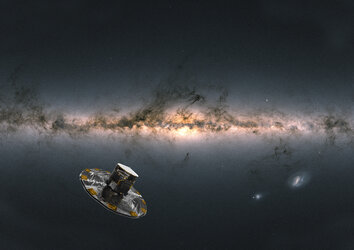Cooperation with the European Commission
Partners in research
ESA plans its technology research in concert with various European actors. Traditionally these include national space or technology agencies. In recent years there has been a significant strengthening of cooperation between the Agency and the European Commission (EC), the executive branch of the European Union (EU).
The EC supports space technology research through its Seventh Framework Programme (FP7). It is also participating in the coordination of European space R&D through the ESA-led European Space Technology Harmonisation Process.
In addition the Commission is involved in the European Cooperation for Space Standardization (ECSS) initiative overseen by the European Committee for Standardisation (CEN). Both the EC and ESA are active through these organisations to promote standards for space activities also encompassing new space technology and products.
The joint ESA/EC European Space Policy
...include strengthening European technological competitiveness...
ESA and the EU are separate institutions but they have largely overlapping national memberships and complementary goals. These include strengthening European technological competitiveness, maintaining our strategic non-dependence and enhancing the quality of life of Europe's citizens.
The European Space Policy, jointly elaborated by ESA and the EC, was unveiled in 2007 and endorsed by the 29 ESA and EU Member States. It is a comprehensive political framework within which to develop and make use of space technologies and systems, so that investment decisions could be made to maximise benefits from space.
Among its stated aims are to foster better coordination of space programmes between ESA, the EU and Member States, increase synergies between civil and space programmes and technologies, and invest to maintain technological expertise and Europe's independent access to space.
Framework Programme
A continuation of the previous Framework Programme 6, Framework Programme 7 runs from 2007 to 2013. It is the first Framework Programme to include a dedicated space budget line. EU Member States have allocated €1.4 billion for funding the space theme over FP7's lifetime, with 85 percent of the total earmarked for GMES activities, the reminder going to Strengthening Space Foundations (SSF), which includes space technology. ESA is supporting EC in the evaluation, negotiation and monitoring of FP7-Space activities.
Besides the FP7-Space thematic, other themes in FP7 are also of high potential interest for the space technology community, namely: Information and Communication Technologies, Security, Transport (including Aeronautics), Nanosciences and Energy, for spinning in high performance cost efficient non-space technology.
Recent examples of ESA activities in the non-space themes of EC’s programmes are the Long Term Advanced Propulsion Concepts and Technologies (LAPCAT) II and Future High-Altitude High-Speed Transport (FAST) 20XX. LAPCAT II is a logical follow-up of the previous LAPCAT I, whose objective was to reduce the duration of antipodal flights (that is, flights between two diametrically opposite points on the globe) to less than four, or even less than two hours.
FAST20XX was one of the projects selected from FP7's aeronautics and air transport second call. FAST20XX will design, develop and experimentally validate hybrid propulsion engines, other technologies and make a recommendation on safe air-launch separation from a carrier aircraft.
Another example, in the embedded systems theme of FP6, was the ASSERT project, which aimed at developing “correct-by-construction” avionics hardware and software. ASSERT proposed a process and a framework to save up to 30% of development and testing effort by early proof of properties based on a model driven approach.
Further cooperation with the EC concerns technology transfer and support to start-ups that build their business on utilisation of space technologies and techniques for non-space applications.















 Germany
Germany
 Austria
Austria
 Belgium
Belgium
 Denmark
Denmark
 Spain
Spain
 Estonia
Estonia
 Finland
Finland
 France
France
 Greece
Greece
 Hungary
Hungary
 Ireland
Ireland
 Italy
Italy
 Luxembourg
Luxembourg
 Norway
Norway
 The Netherlands
The Netherlands
 Poland
Poland
 Portugal
Portugal
 Czechia
Czechia
 Romania
Romania
 United Kingdom
United Kingdom
 Slovenia
Slovenia
 Sweden
Sweden
 Switzerland
Switzerland


























